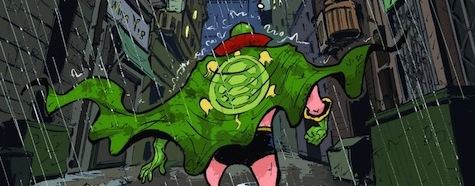I turned forty last year.
When I was a kid, forty seemed like a lifetime away. I didn’t think about forty all that much, but when I did I imagined I’d have life figured out. By the time I got that old, I’d have cracked the code.
My actual fortieth year has been a blur of ink and airplane trips and diapers. Most days feel chaotic, but it’s a satisfying sort of chaos. And while I definitely haven’t cracked the code, I have learned a few things along the way.
That’s why, when I get asked for advice by aspiring cartoonists, I feel that I have something to offer. The following is for those of you considering a career in comic books. I hope you find it helpful.
1. Decide what’s more important to you: expressing yourself or earning a living through art.
Money and self-expression aren’t mutually exclusive in the long run, but in the short term they usually are. Books are a difficult way to make money. Independent, creator-owned comic books? Near impossible, especially when you’re just starting off.
If your primary objective is to make money through art, I’d suggest switching to a related field: animation, graphic design, web design. You’ll most likely be using your talents executing other people’s visions, but these sorts of jobs can still offer enough creative elbow room to be satisfying.
Don’t get me wrong—becoming a successful animator or graphic designer can be just as difficult as becoming a successful cartoonist, but at least you’ll have a chance at working for a company that offers health insurance.
But if what you really want is to get a deeply personal vision out of your head and onto paper, get a day job. Get a day job you like, one that leaves you with enough time and energy to work on your dream project on the side. As I’ve expressed in a previous post, I’m a big fan of day jobs. I’ve taught at the high school or college level for my entire cartooning career. My day job isn’t just a source of income, it’s also a source of inspiration for my books. Interacting with a variety of people on a daily basis naturally leads to stories.
2. Explore different ways of making comics.
When I began drawing comics, I drew on Bristol board, using a brush and a bottle of ink. Why? Because that’s how Stan Lee and John Buscema told me to do it in their book How To Draw Comics The Marvel Way. After meeting other cartoonists, however, I realized that The Marvel Way isn’t the only way. If you talk to ten cartoonists, you will probably find that they use ten different sets of tools. Heck, if you talk to one cartoonist at ten different points in her career, you will probably find that she’s gone through ten different sets of tools. There is no one right way to make comics, and art tools are personal. Experiment, read books besides How To Draw Comics The Marvel Way, get pointers from friends. Especially that last one. Nothing educates you on cartooning like having cartoonist friends. Which brings me to my next point:
3. Find a community of like-minded people.
I was lucky enough to fall in with a shockingly talented group of cartoonists when we were all in our twenties: Derek Kirk Kim, Lark Pien, Jason Shiga, Jesse Hamm, Thien Pham, Ben Catmull, Jason Thompson, and a bunch of others. We used to hang out once a week. We would draw together, critique each other’s writing, talk shop. I never went to art school, so my friends were my comics education. I learned about storytelling from them. I tabled with them at conventions. I even got publishing deals through them. Derek Kirk Kim introduced me to my current editor.
Making comics can be a lonely affair because you spend most of your days cooped up in your studio, alone at your drawing table. But the truth is, success often occurs within the context of a community. You have to find that community, grow it, and nurture it.
4. Go write. Go draw. Right now.
Have a groundbreaking idea for a graphic novel? That’s great, but I’ve got to be honest: Ideas are cheap. Everybody has at least one groundbreaking idea for a story. Most people have several.
But most people don’t have the determination to do something about it. If you actually sit down and write your story, if you draw it out in panels, you put yourself several steps ahead. Set goals for yourself. Give yourself a few weeks or a few months to mull over an idea, to do sketches of it in your sketchbook, to talk to friends about it. But once those week or months are over, you’ve got to move on to the actual writing and drawing, no matter how scared you may feel. You have to force yourself to do it.
A great idea that’s still stuck in your head might seem big and important, but in reality it’s a small and feeble thing. A successfully executed great idea, on the other hand? One that’s made the journey out of your head and onto something tangible? That’s powerful enough to change the world.
So go do it. Punch your excuses in the face.
Go write. Go draw. Right now.
Gene Luen Yang’s first book with First Second, American Born Chinese, is now in print in over ten languages and was a National Book Award finalist and winner of the Printz Award. Yang’s other works include the popular comics adaptation of Avatar: The Last Airbender, and the New York Times Best-Selling graphic novel diptych Boxers & Saints. The Shadow Hero, the story of the first Asian-American superhero is his most recent graphic novel. It is being published in six e-issues, starting in February, 2014; the sixth and final issue will be available on Tuesday, July 15th.










